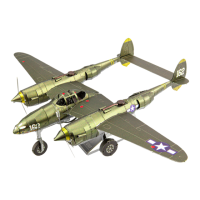
Do you have a question about the Lockheed P-38 Lightning and is the answer not in the manual?
| Manufacturer | Lockheed Corporation |
|---|---|
| First flight | 27 January 1939 |
| Introduced | 1941 |
| Retired | 1949 (United States Air Force) |
| Produced | 1941–1945 |
| Number built | 10, 037 |
| Crew | 1 |
| Length | 37 ft 10 in (11.53 m) |
| Wingspan | 52 ft 0 in (15.85 m) |
| Height | 12 ft 10 in (3.91 m) |
| Max takeoff weight | 21, 600 lb (9, 800 kg) |
| Service ceiling | 44, 000 ft (13, 400 m) |
| Rate of climb | 4, 750 ft/min (24.1 m/s) |
| Role | Fighter |
| Primary users | United States Army Air Forces, Free French Air Force |
| Empty weight | 5, 800 kg |
| Powerplant | 2 × Allison V-1710 liquid-cooled V12 piston engines |
| Maximum speed | 414 mph (666 km/h, 360 kn) at 25, 000 ft (7, 600 m) |
| Range | 1, 300 mi (2, 100 km) |
| Armament | 1 × 20 mm Hispano M2 cannon, 4 × .50 caliber (12.7 mm) M2 Browning machine guns |
Details flight limitations, negative acceleration limits, and altitude restrictions for acrobatics.
Lists maximum allowable airspeeds for various configurations like diving, extended landing gear, and flaps.
Outlines pre-flight checks for battery, fuel selectors, oxygen, throttles, and propeller controls.
Covers checks for propeller circuits, mixture, oil coolers, generators, intercoolers, and fuel systems.
Explains fuel usage sequence, drop tank procedures, and warnings for tail-heavy conditions.
Details procedures for long-range flights and fuel crossfeed operations between tanks.
Provides steps for starting engines, including checks for fuel pressure, magnetos, and propeller controls.
Covers checks for the automatic pilot system and its control valve before take-off.
Lists final checks before take-off, including hatch, controls, flaps, and tabs.
Details taxiing, take-off sequence, landing gear retraction, and climb parameters.
Describes torque effects, power adjustments, supercharger operation, and aircraft stability.
Explains stall speeds at different weights and procedures for spin recovery.
Discusses the function and usage of dive recovery flaps for steep dives.
Covers general approach, normal landing, and go-around procedures with detailed steps.
Provides instructions for handling single engine failure, feathering, and single-engine approaches.
Details practice procedures for unfeathering propellers and handling engine failures.
Outlines procedures for handling a complete engine failure, including ditching preparations.
Covers engine fire procedures and recommended methods for emergency exit.
Explains how to use flight operation charts for planning, fuel sequence, and range calculations.
Lists engine specs, max RPM, fuel selector positions, and operating ranges for temperatures and pressures.
